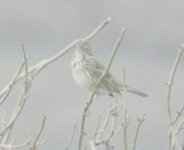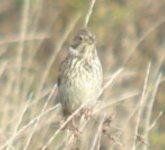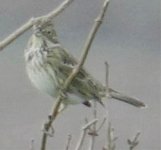OK. Hands Up! I surrender!
When I first saw this image I was adamant it was a Reed. But those coverts!
Somehow it just couldn’t be turned into a Rustic!
Like most of us I’ve been studying these images over and over.
Right up until today I was sure it was a Reed.
However, the camp for Corn as an ID was niggling at me. I just couldn’t see it at all.
Even the paintshop CB trials hadn’t convinced me.
So I put the image into photoshop. Tried all kinds of treatments on it.
But, the mind is always trying to make sense of what it perceives, to translate it into something it recognises. It examines the available evidence and makes a decision based on what is more familiar to it.
For me it was the abundance of brown to russet tones in the original pic, coupled with the (apparent) high peaked crown, a sure feature of Reed and Rustic!
So, in Photoshop, my brain wanted to make that so. So I upped the balances to get closer to my ID. But the more I did this, the more unidentifiable the bird became! I almost created a new species! Pretty fine one by the way! (And I’ve ticked it!)
Was then the camera taking an auto reading over-compensating for the odd conditions? Giving the impression of brown/russet tones? I strongly believe so now.
Why did the crown appear so peaked and raised?
I looked at this in juxtaposition with the twig that seems to touch it. (The eye tries to match the twig to the crown…confusing…)
It’s odd, but I now think the bunting’s been snapped in a moment/perspective that is unusual.
Its head is at an odd angle to its body giving a false capture of how its head really looks (a foreshortening element, compressing the face in a strange way?)
Then I went against my ego, and decided to see if I could turn it into a Corn - by messing with the colour, brightness, contrast, saturation, hue, etc.
I came up with this image. (See below).
With all these balances jigged, it struck me suddenly that I had been wrong!
This IS a Corn Bunting! (See what you think from the attached)
So apologies to all who called it as CB and I disagreed.
I should’ve trusted your admirable instincts!
I’ve loved this thread. Because I think it has been about the way we interpret what we see, based on the way our mind works. And sometimes we can be forgiven for that. Making sense of our world is hard enough, but the joy of BF is that it makes it that little bit harder, and ultimately more ENJOYABLE!
The camera never lies?
Oh yes, it flippin’ well does!!!! ;D
PS It’s still ok for Winter Reeds to be up on the Downs. I’ve had ‘em in the weirdest of places. But I’m firmly in the Corn Camp on this one now! (and yes I hang my head!) (Sounds of much “Hat Munching” …)
These by Roy convinced me….
‘Roy:
The toes and claws are extremely long - dangling over the branch - which is a quintessentially Corn Bunting feature (feet/claws more "normal" on Reed and most other Emberiza).
The eyering flares above and below the eye and is quite narrow along the front edge - a typical Corn appearence (narrow all the way round on Reed).
The pale cheek spot is neatly demarkated and rather long, reaching forward almost level with the eye (usually more diffuse and further back on Reed).
Also, the legs appear to be pale (usually dark on Reed), though obviously the precise colour is not trustworthy.
Plus of course, as Nickderry and others have said, that hefty yellowish concave bill is a dead giveaway...
Any post-hoc image manipulation is going to be subjective, so "true" colours are impossible to know for sure. My manipulation was purely based on my opinion of what light levels would have been like.
Of course, I could have manipulated the image in the other direction to enhance the red tones (try it if you like!). The killer point is that no matter how much you enhance in that direction, the bird won't begin to resemble anything else - there simply isn't another candidate species that looks like this bird. Even the hybrid theories aren't that tempting (unless someone's going to claim Corn X Chestnut-eared!).
Everything odd about this bird can be explained by a quirk of image capture. Shape, "jizz" and plumage patterns fit squarely within CB variation (in my opinion).
(I'd also add that CB can show a faint yellowish wash to the breast, particularly in winter).
At first glance I was confused by the images - I was happy to rule out Reed (combination of pale wing coverts fringes, head and breast pattern, shape/structure etc.) but no other species seemed to fit quite right either...
So hats off to those who suggested Corn early on! Once you accept that the colour representation is not entirely accurate, it instantly becomes clear that's what it is - everything fits bar the apparent rufous tones. I suspect the "misty conditions" caused the camera to adjust white balance, which have introduced more red tones to the image than were there in reality (note that the branches and background also have a slightly unnatural purplish-red hue).
If it weren’t for these, I wouldn’t have done a Photoshop on it. Being wrong and admitting it can teach you a lot about yourself. Thanx!








